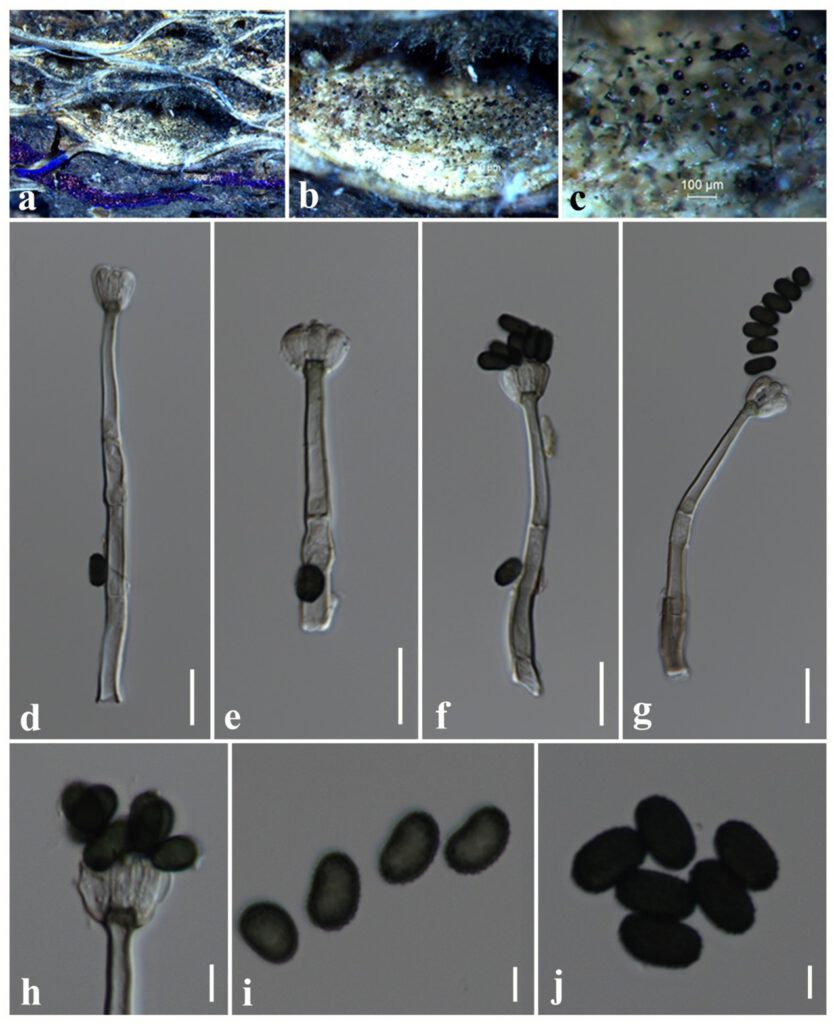Memnoniella ellipsoidea L. Lombard & Crous, Persoonia 36: 197 (2016)
MycoBank number: MB 816005; Index Fungorum number: IF 816005; Facesoffungi number: FoF 10668; Fig. **
Saprobic on dead twigs attached to Cananga odorata. Sexual morph: Undetermined. Asexual morph: Hyphomycetous. Conidiophores 50–130 × 3–6 µm ( = 100 × 4.5 μm, n = 20), macronematous, mononematous, erect, simple, straight or flexuous, unbranched, smooth, thick-walled, septate, bearing at its apex a crown of phialides, light brown at the base, olive grey to light brown at the apex, wider at the base, bearing a whorl of 3–6 conidiogenous cells. Conidiogenous cells 11–13 × 4–5 µm μm ( = 12 × 4.5 μm, n = 20), monophialidic, discrete, determinate, terminal, clustered at the apex of conidiophores, clavate to subcylindrical, smooth, subhyaline to light brown. Conidia 9–11 × 4–7 µm ( = 10 × 5.5 μm, n = 30), acrogenous, aseptate, ellipsoidal, olivaceous brown to dark brown, verrucose, with 1-2 large guttules, thick-walled, rounded at both ends.
Culture characteristics – Colonies on PDA reaching 20 mm diameter after 2 weeks at 25°C, colonies from above: circular, margin entire, flat, surface smooth, white at the margin, cream in the centre; reverse: cream at the margin, pale brown in the centre.
Material examined – THAILAND, Chiang Rai Province, dead twigs attached to Cananga odorata (Annonaceae), 2 January 2019, N. I. de Silva, CO2 (MFLU 21-0236), living culture, MFLUCC 21-0170.
Known hosts and distribution – On a dead twig Bromelia sp. in Brazil (Lombard et al. 2016), on dead twigs attached to Cananga odorata in Thailand (this study).
GenBank numbers – LSU: OK179728, ITS: OK284456.
Notes – Our collection (MFLU 21-0236) shares similar morphology with Memnoniella ellipsoidea in having macronematous, mononematous, erect, simple and septate conidiophores, monophialidic, discrete, determinate, terminal, clavate to subcylindrical conidiogenous cells and aseptate, ellipsoidal, olivaceous brown to dark brown conidia (Lombard et al. 2016). Multi-gene phylogeny (LSU, ITS, BTUB and RPB2) also indicates that our collection clustered with Memnoniella ellipsoidea isolates (CBS 136199, CBS 136200, CBS 135201 and CBS 136202) in a 75% ML, 100 BYPP supported clade (Fig. **). Therefore, based on both morphology and phylogeny evidence, we introduce our collection as a new host record of Memnoniella ellipsoidea from Cananga odorata in Thailand.

Figure ** – Memnoniella ellipsoidea (MFLU 21-0236) a–c Conidiophores on the substrate surface. d, e Conidiophores. f, g Conidiophores with attached conidia. h Conidiophore with conidiogenous cells and attached conidia. i, j Conidia. Scale bars: c = 100 μm, d–g = 20 μm, h–j = 5 μm.
